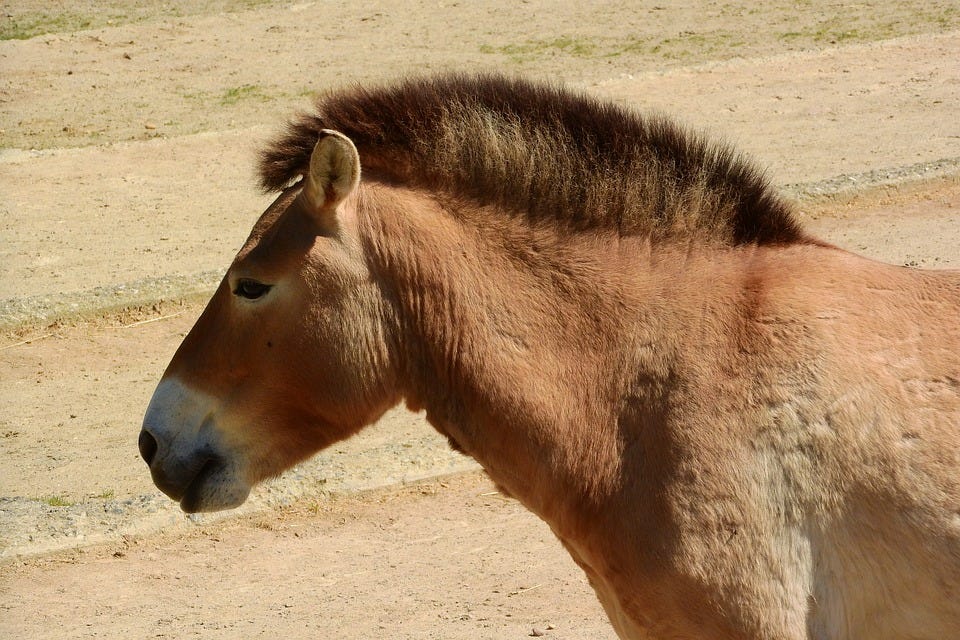Reviving the Wild: The Astonishing Comeback of Przewalski's Horses
From the Brink of Extinction to Mongolia’s Steppes: The Unyielding Comeback of the World’s Last Wild Horses
In the vast, windswept steppes of Mongolia and Central Asia, a unique species of horse once roamed freely, embodying the wild spirit of the region. Known as Przewalski's horse (Equus ferus przewalskii), these animals are the last truly wild horses on Earth. Unlike the feral mustangs of North America or the brumbies of Australia—domesticated horses that have returned to the wild—Przewalski's horses were never tamed by humans. Their journey from near extinction to a symbol of successful conservation is a testament to global efforts to preserve biodiversity.

A Species on the Brink
Przewalski's horses, named after Russian explorer Nikolai Przewalski who first described them in the late 19th century, once thrived across Europe and Asia. However, by the mid-20th century, human encroachment, habitat loss, and competition with livestock drove these horses to extinction in the wild. The last confirmed sighting in their native habitat occurred in the 1960s in Mongolia’s Gobi Desert.
At their lowest point, only a handful of Przewalski's horses remained in captivity—around 12 to 14 individuals. This small population represented the last hope for saving the species from total extinction. The horses were kept in zoos around the world, and a rigorous breeding program was established to ensure their survival.
Zoos: A Rare Success Story
While I have been critical of zoos for their ethical shortcomings and failure to prioritize animal welfare over entertainment or financial gain, the case of Przewalski's horses stands out as a rare exception. Through carefully managed breeding programs, zoos played an indispensable role in saving this species from extinction. Today, thanks to these efforts, there are approximately 2,500 Przewalski's horses worldwide, with about half living in the wild due to reintroduction programs in Mongolia, Kazakhstan, and China.
This success story underscores that while many zoos fall short in their conservation claims, there are instances where captive breeding programs have made a significant impact. In this case, zoos have not only preserved genetic diversity but also facilitated the reintroduction of these horses into their natural habitats ensuring their long-term survival.
What Makes Przewalski’s Horses Unique?
Przewalski’s horses differ from domestic horses in several key ways. One of the most striking differences is their chromosome count. While domestic horses have 64 chromosomes, Przewalski’s have 66. This genetic distinction underscores their status as a truly wild species.
These stocky horses are smaller than most domestic breeds, standing about 48-56 inches at the shoulder and weighing between 440-750 pounds. They have a distinctive upright mane and a robust build suited for surviving harsh environments.
Unlike feral horses that have adapted to human presence over time, Przewalski’s horses retain many behaviors typical of undomesticated animals. They are more skittish around humans and have retained their natural instincts for survival in the wild.
Challenges Ahead
Despite their remarkable recovery, Przewalski’s horses continue to face significant challenges. One of the most pressing issues is their limited genetic diversity, which makes them particularly vulnerable to diseases and environmental changes. To combat this, conservationists are exploring advanced methods like cloning to bolster genetic variation within the population.
In 2020 and again in 2023, scientists successfully cloned foals using cryopreserved cells from a stallion that lived in the 1980s. These clones have introduced valuable genetic diversity into the population. While cloning opens up exciting possibilities for enhancing genetic resilience in endangered species like Przewalski’s horses, it is not without its limitations. Cloning remains an inefficient process with potential health risks for the animals involved. Moreover, ethical concerns about animal welfare and the long-term viability of cloned individuals underscore that cloning should be viewed as a complementary tool rather than a primary solution.
For long-term success, cloning efforts must be paired with broader conservation strategies that address the root causes of species decline. Habitat degradation—driven by illegal mining and military activity in Mongolia—remains a significant threat to Przewalski’s horses. Additionally, hybridization with domestic horses poses a risk of diluting their unique genetic makeup, further complicating conservation efforts. Protecting their natural habitat and preventing crossbreeding are essential to ensuring the species' survival in the wild.
A Symbol of Hope
The story of Przewalski's horse is not just about saving a species; it's about restoring balance to ecosystems that rely on these animals. In places like Mongolia's Hustai National Park and Kazakhstan's "Golden Steppe," these wild horses play a crucial role in grassland ecologies, preventing overgrowth of certain plants and aiding in nutrient cycling, which benefits other native species.
As conservation efforts continue, these resilient creatures stand as a symbol of hope—proof that even species teetering on the brink can be brought back through dedication, science, and global cooperation. Their journey from near extinction to a symbol of successful conservation is a testament not only to global efforts to preserve biodiversity but also a sobering reminder of humanity’s role in their decline.
As we face a future where biodiversity is increasingly at risk, the story of Przewalski's horse is a powerful reminder that with science, dedication, and global cooperation, we can protect and restore what humanity has nearly lost.
Ed Boks is a former Executive Director of the New York City, Los Angeles, and Maricopa County Animal Care & Control Departments, and a former Board Director of the National Animal Control Association. His work has been published in the LA Times, New York Times, Newsweek, Real Clear Policy, Sentient Media, and now on Animal Politics with Ed Boks.






. Thank you for all these very detailed and informative articles!
Good article. I am lucky to live just ten miles north of a herd of Przewalski's horses at The Wilds, a 10,000 acre refuge for exotic hoofed animals built on former strip-mined land turned to grasslands in eastern Ohio. https://www.thewilds.org/animals/przewalskis-wild-horse